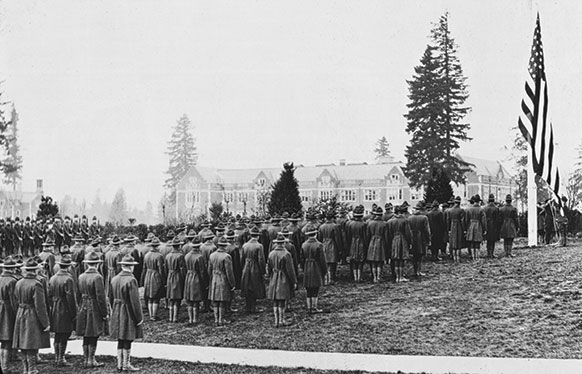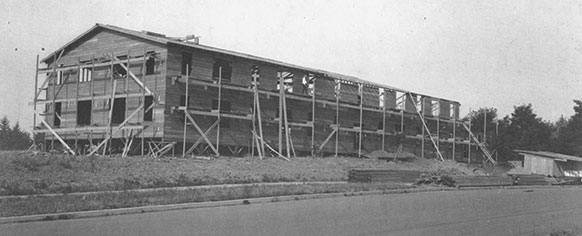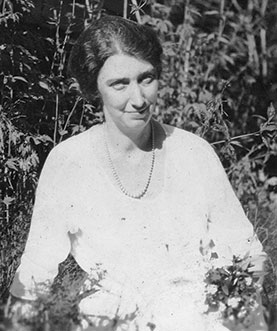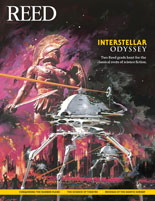
IRIS login | Reed College home Volume 94, No. 1: March 2015
The Pacifist Menace (continued)

Partly on the strength of Foster’s report and further prompting, the Student Army Training Corps was organized in hundreds of colleges. In a July 18, 1918, letter to all students, Foster announced they were all “drafted into the servis of your country,” and would be provided with a uniform, receive instruction by U.S. Army officers, and most importantly, “go on with the studies of [their] choice.” Wilson echoed Foster’s own pleas that summer. “After the war there will be urgent need not only for trained leadership in all lines of industrial, commercial, social and civic life, but for a very high average of intelligence and preparation on the part of all people,” he declared. “I would therefore urge that the people continue to give generous support to their schools of all grades.” Wilson called Reed specifically “a bulwark of national defense” and said “it will be a public calamity if the work of the college is to suffer” during the war due to a lack of private financial contributions. Reed could now solicit donations for the war effort, but it still had more men serving overseas in the army or navy than in its classrooms. Foster and Wilson told students that the U.S. now lacked physicists, chemists, psychologists, biologists, draftsmen, and accountants (and other professions trained through the humanities) who were willing to serve their government.
A Quest editorial from 1917 called on students to concentrate their anxiety about war into their studies: “Instead of expending all that precious energy into merely being excited, work it into your themes, enliven your thesis with it, employ it in ferreting out the truths of science in laboratory, project a little of that pep into Greek and Latin, attack math with bayonets and the German with military tactics.”
Return address, 1st Regiment U.S. Engineers, “Somewhere in France” postmark:
The artillery at the Front is very active at times, and the “Boom, Boom B-r-r-oom” of the big guns makes the whole earth seem to shake, but outside of occasional raiding Boche airplanes, or a big gas attack, when we are working behind the lines, we have nothing to fear from the Germans.
I believe that the Americans will prove the deciding factor in this war game if they are ever turned loose, and I hope that we will get into it, hot and heavy, before the spring is over. Most of us expect to be home in time for the opening of college next fall, and some of us even plan on spending the 4th of July in the good old U.S.A.
—Excerpt from a February 19, 1918, letter from Forrest Foster ’22 (no relation to President Foster)
While “hastily planned and far from perfect,” Foster viewed authorization for a Reed branch of the training corps as a good first step toward keeping student-age men in school. The next step was to build a barracks. To do this, he asked Harvey Eugene Davis [superintendent of buildings 1911–48] to go across the Columbia River and borrow blueprints of the army barracks at Vancouver and build a copy on the Reed campus. By fall 1918, the 200-person Student Army Training Corps Barracks was constructed on campus facing Woodstock Boulevard, just south of the present Hauser Library.
Two months after the building was completed, November 11, 1918, the Armistice was signed.
It took a full year for the U.S. government to reimburse Reed for the barracks—a delay that the college could ill afford. To keep the college open, Foster had to ask the board members, who were old and infirm by this point [Dolph was deceased], for emergency transactions of several hundred thousand dollars at a time—tens of millions in today’s dollars.
During the war, Foster had been able to raise substantial sums for emergency use. When the emergency and patriotism died down after the war, however, the atmosphere turned chilly. Portlanders remembered Foster’s outspoken pacifism, and rumors still circulated about him being a German spy in a U.S. uniform. Reed’s daring academic experiment was in danger of being hijacked by his notoriety.
With his reputation preceding him into the living rooms of local families and potential wealthy donors, Foster resigned and urged Reed trustees to find a president who could save the college financially. He was not the right man, he said, because he “had been a leader in too many off-the-campus fights; too many for the good of Reed College . . . . I had the courage of my convictions—foolhardy courage at times—but I lacked the courage of my emotions.”
How genuine was Foster’s change of heart? That’s a difficult historical question, even with his personal testimony, because it requires evaluating whether he cynically made the appearance to back Wilson in a desperate attempt to save Reed. It’s impossible to know for sure, but Wilson, as his mentor, could have easily told him that serving in the Red Cross, despite his deeply divided feelings about the war, could shore up Reed’s battered public image, thereby advancing its cause of academic excellence through its ability to solicit “emergency war-effort contributions.”
However, the fact that Foster not only put on that Red Cross uniform—but also fully deployed his influence in that capacity worldwide—suggests his motives were genuine. After visiting 10 universities across the nation, Foster came back apparently convinced that loyalty to country could come without sacrificing ideals. He addressed the student body in the Reed chapel on May 14, 1917, saying that he witnessed college men “responding superbly to the call of the nation in this crisis” by putting in an hour or two of military training at 5 a.m. before beginning the usual day’s work. “Colleges are offering all their resources—human and material—without a thought of self-protection. Traditionally the torch-bearers of idealism, they are true in this crisis to the noblest epochs of history. Nothing more could be desired than that the whole country could come to comprehend the seriousness of the war and to feel the eagerness to face duty as have our universities and colleges.” Surely, Foster could have satisfied Wilson’s demands and done much less for the war effort.
In his memoirs, written during the late ’40s, Foster said that he appreciated the trustees’ commitment to academic freedom: “They knew, moreover, that where everyone thinks alike, few are doing any thinking at all. When I consider the kind of world which has resulted from two wars—wars for which we are still paying billions—I wonder what will be the long view of history.”
Foster’s outspoken pacifism had brought Reed to the brink of financial ruin. But once war was declared, his determination to have Reed play a meaningful role in the war effort probably saved it.
After Foster resigned in 1919, the trustees resolved never again to allow Reed’s fate to be bound up with a political position—an attitude that would persist for decades and which in many ways still echoes today.
![]()

Reed’s Student Army Training Corps Barracks was completed in September 1918—two months before the Armistice was signed.
Reed and World War I

At Reed, Dr. Mary McMillan ran the nation’s first program to train young women to become “reconstruction aides” focusing on physical and occupational therapy for returning veterans.
Anxious for Reed to play a role in the war effort, President William Trufant Foster created the nation’s first program to train young women to become “reconstruction aides” focusing on physical and occupational therapy for returning veterans.
The program was run by Dr. Mary McMillan [director of the Reed clinic 1918–19], who later became a legend in the field of physical therapy. Trainees took classes in biology, anatomy, physiology, personal hygiene, psychological aspects of recovery, posture, theory of bandaging, military hospital management, massage, corrective gymnastics, and orthopedic surgery.
Dr. McMillan once described the case of an ambulance driver who was brought back from Europe after a raid on a Red Cross hospital: “He had been standing with two companions. Then came the awful explosion. He was knocked down. He didn’t lose consciousness. He found himself lying on the floor. On either side were his comrades. They had been blown to pieces . . . . ‘Oh they’re dead, and I’m not’ was the thought that went through his mind. It was curiously detached . . . . There was no great regret for their going, no great rejoicing that he was saved . . . . The amputations are necessarily quick work—guillotine operations, we call them. Often the muscles must be shrunk down over the bone-end by us, which is done by tight bandages and heavy weights . . . we often have to flatten out the bone-end by exercises so that it will bear weight.”
McMillan’s first cases never left her memory: “Bearded, broken men . . . came with their clothes caked in mud and their own blood. They were half demented with the thing that had befallen. They had lost their wives, their children, their all. They let us care for them as we would. The first thing was to cut their clothes from them. We took their garments into the yard and in a great pile burned them.”
She prescribed daily gymnastic exercises and out-of-door games for all students to prepare for their arduous work in military hospitals. Mornings were spent attending clinics at various Portland hospitals and leading patients through exercises and massage. Reed graduated about 200 aides altogether; three died in the line of duty from influenza acquired in hospitals.
One of the aides, Col. Emma Vogel ’18, joined the Reed faculty to help train students in subsequent classes. After succeeding McMillan as head aide of the Department of Physiotherapy at Walter Reed Hospital in Washington, D.C., Emma became the first director of physical therapists in the U.S. Army.
At least 93 Reed students, professors, and alumni served in World War I. A bronze plaque at the entrance to Eliot Hall lists 12 students who died in the line of duty; many more were wounded.
Among those who served:
Neil Malarkey ’19: (son of Dan Malarkey, the state senator who denounced Foster as a traitor) joined the troops to France and was badly burned when a large timber fell on a tank of ammonia, causing it to rupture. He returned to Reed, graduated in English, and went on to became a district attorney and was elected as an Oregon state representative for Multnomah County.
Howard Hopkirk ’20: served as a first lieutenant and returned to write his thesis on press associations and newspaper reporters. He became an influential figure in social work, authoring the book Institutions Serving Children and becoming executive director of the Child Welfare League of America.
Glenn C. Quiett ’20: served on the front lines in France, where he was exposed to poison gas and lost a lung. He returned to Reed and graduated in English, writing his thesis on the French playwright Eugene Scribe, whom he quoted thus:
You believe, like everyone else, that political disasters, revolutions, the fall of empires stem from deep, profound, important reasons. Don’t you know that it was a window in the Trianon castle, criticized by Louis XIV and defended by Louvois, that gave birth to the war which now grips Europe?
Glenn went on to write the seminal history of 19th-century American expansion, They built the West: An Epic of Rails and Cities. He died of tuberculosis in 1936; his friends and family raised money to build the Quiett infirmary that stands just north of Eliot Hall. When the building was dedicated, his aunt brought a bouquet of red carnations—Glenn’s favorite flowers—to adorn the entrance.
- Previous Page
- 1
- 2
- Next Page

LATEST COMMENTS
steve-jobs-1976 I knew Steve Jobs when he was on the second floor of Quincy. (Fall...
Utnapishtim - 2 weeks ago
Prof. Mason Drukman [political science 1964–70] This is gold, pure gold. God bless, Prof. Drukman.
puredog - 1 month ago
virginia-davis-1965 Such a good friend & compatriot in the day of Satyricon...
czarchasm - 4 months ago
John Peara Baba 1990 John died of a broken heart from losing his mom and then his...
kodachrome - 7 months ago
Carol Sawyer 1962 Who wrote this obit? I'm writing something about Carol Sawyer...
MsLaurie Pepper - 8 months ago
William W. Wissman MAT 1969 ...and THREE sisters. Sabra, the oldest, Mary, the middle, and...
riclf - 10 months ago